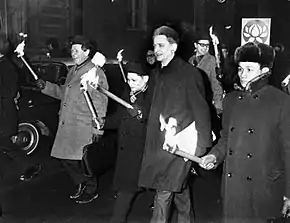Vietnam War resisters in Sweden
Vietnam War resisters in Sweden were Americans that fled to Sweden to avoid service in the Vietnam War between 1967 and 1973. Among the 1,000 American exiles included around 800 military deserters. Unlike other nations like Canada that discretely harbored Vietnam War resisters, the Swedish government granted war resisters asylum status and the public openly welcomed them. This unique acceptance and Swedish politicians' open protests against American involvement in the Vietnam War caused a rift in relations between the United States and Sweden.[1][2]

History
During the Vietnam War 503,926 desertions occurred in the United States military. Most deserted in the United States, but some fled to other countries. During the war American servicemen were often stationed in or took retreats to Japan, and had trouble deserting while there due to the language barrier. Activists from the Japanese leftist group Beheiren devised a way to reach out to servicemen and assist them in deserting. Sweden became the target destination for deserters because it was the only country that granted asylum to Vietnam War deserters.[3]
Sweden's granting of asylum to deserters worsened relations between Sweden and the United States. In 1969 the United States revoked its ambassador to Sweden in protest.[4]
Of the 1,000 American war resisters that would come to Sweden two thirds were deserters rather than draft evaders. Very few would stay in Sweden for their lives, and the few that remained assimilated into Swedish society.[5] Those that remained over the years typically did so because of a distaste for American politics or because of careers and family now in Sweden.[6]
People
Deserters
Most deserters reported their decision to desert was spontaneous. Around 100 black Americans deserted to come to Sweden, but had little plans to live for long in Sweden, and most eventually left the country.[5] Many deserters had trouble navigating Swedish culture, guilt with abandoning their army compatriots, and had trouble keeping relationships with people in the United States, usually due to geographic distance or controversy from their decision to desert.[7]
Draft evaders
Draft evaders typically had an easier time adapting to Swedish life because unlike deserters, most were college educated and familiar with the anti-war movement. They also did not have troubles finding ways to immigrate unlike military deserters who had to escape from the U.S. military.[7]
References
- Scott, Carl-Gustaf (2001). "Swedish Sanctuary of American Deserters During the Vietnam War: A Facet of Social Democratic Domestic Politics". Scandinavian Journal of Politics. 26 (2): 123–142. doi:10.1080/034687501750211145. S2CID 143807347.
- Scott, Carl-Gustaf (2015). "'Sweden Might Be a Haven, But It's Not Heaven': American War Resisters in Sweden During the Vietnam War". Immigrants and Minorities. 33 (3): 205–230. doi:10.1080/02619288.2014.923992. S2CID 144978578.
- Turner, Matthew (August 3, 2018). "The Vietnam War Deserters Who Sought Asylum in Sweden". lithub.
- Stewart, Luke. "'Hell, they're your problem, not ours': Draft Dodgers, Military Deserters and Canada-United States Relations in the Vietnam War Era". Open Edition.
- Feder, Barnaby J. (June 17, 1985). "DESERTERS IN SWEDEN: AN ODD LITTLE 'V.F.W. POST'". New York Times.
- Eichel, Larry (December 9, 1990). "Home Swede Home: Why Some Vietnam Dodgers Haven't Returned". The Seattle Times.
- Nilsson, Maria (January 13, 1989). "AMERICAN EXILES". Chicago Tribune.